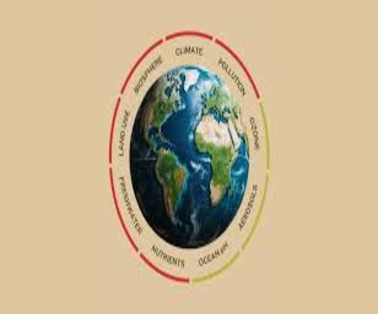The world has breached six of the nine planetary boundaries necessary to maintain Earth’s stability and resilience, according to a new study.
Key Points
- The study, published in Science Advances, was carried out by 29 scientists from eight different countries.
- The findings are an update to the planetary boundaries framework that was launched in 2009 to define the environmental limits within which humanity can safely operate.
- The planetary boundaries framework was first proposed by Johan Rockström and a group of 28 internationally renowned scientists
- Breaching of these boundaries doesn’t indicate an immediate catastrophe but raises the risk of irreversible environmental changes.
- This situation could lead to conditions on Earth that no longer support our current way of life.
What Are Planetary Boundaries?
Planetary boundaries refer to the critical thresholds for key environmental processes that maintain Earth’s resilience. Crossing these boundaries risks triggering abrupt, irreversible changes with devastating consequences for both nature and human society. Here are the key planetary boundaries and how they have been impacted:
Climate change
The concentration of carbon dioxide (CO2) in the air has increased immensely. Some of the implications, such as the melting of polar ice sheets, are irreversible. Sea levels are rising, and Earth is getting warmer than ever since it became habitable for humans. The ongoing loss of the world’s rainforests is another alarming tipping point because it signals the weakening or reversal of terrestrial carbon sinks.
Biodiversity integrity loss
Many species of our diverse flora and fauna are not only endangered, but they’re also going extinct. This is happening due to the constant demand for food, water, and natural resources. Biodiversity is being disturbed both by an increase in global temperatures and by civilizations excessively and irresponsibly clearing out the land.
Altered biogeochemical cycles
Modern agriculture methods were adopted to increase yield to feed growing populations. However, the use of fertilizers has added many gases to the atmosphere. The industries where fertilizer production takes place—and the use of these in agriculture—are equally responsible for increasing greenhouse gases. Although nitrogen and phosphorus increase the yield, a significant portion of these reaches the oceans and threatens marine life.
Land system change
Forests, wetlands, and grasslands are being converted into agricultural land to sustain the world’s population and be fit for human use. This is a change in land use — instead of reforestation, humans are removing forests to make available more land for cultivation. Changes in the land system have affected CO2 concentrations, water flows, biodiversity, and ecosystems.
Freshwater use
Research shows that by 2050 almost half a billion people will experience water scarcity. Freshwater resources are being affected by excessive usage by industries. Human modification of water bodies has a catastrophic impact on the environment, from changes in river flows and irregular vapor movements on a global scale.
Ocean acidification
Almost a quarter of CO2 in the atmosphere makes its way into oceans. When it reaches the water, it forms carbonic acid. This, in turn, decreases the pH of surface water. The increased acidity has ramifications on global marine environments — it mitigates the carbonate ions necessary for corals, shellfish, and many other species to grow.
Chemical pollution and novel entities
Novel entities are defined as new chemicals, new forms of existing substances, and changed life forms that can have undesirable geophysical and biological consequences. Many of these have been introduced into the environment due to fundamental human-driven changes. The effects of these entities are long-term: they reduce fertility and increase the potential of permanent genetic damage in the generations to come.
Ozone layer
The ozone layer is responsible for filtering out the harmful ultraviolet rays from the sun. In the 1980s, the increased concentration of chemicals created a hole in the layer. When the layer gets thin, increased amounts of Ultraviolet rays make their way towards the Earth. And this, in turn, threatens the marine and terrestrial biological systems.
Atmospheric aerosol loading
Atmospheric aerosols affect global atmospheric circulation systems. The aerosols can formulate clouds that can cool and warm the Earth outside of standard natural cycles. Aerosols especially tend to affect the monsoon systems in tropical areas. The presence of aerosols also affects the reflection and absorption of solar rays in the environment
Breached Planetary Boundaries
The six boundaries include

Details on Breached Planetary Boundaries
- For land system change, the global area of forested land as the percentage of the original forest cover boundary has dropped from 75 per cent to 60 per cent, which is beyond limits safe.
- As for biosphere integrity, the researchers kept a limit of less than 10 extinctions per million species-years. But the study estimated the extinction rate was greater than 100 extinctions per million species-years.
- Currently, it is estimated around one million of the 8 million plant and animal species are threatened with extinction, and over 10 per cent of the genetic diversity of plants and animals may have been wiped out over the last 150 years.
- The analysis also showed that violations of blue and green water boundaries occurred in 1905 and 1929, respectively.
- The planetary boundary of novel entities was calculated to be zero. This means humans have transgressed this limit as well.
- Flows of nutrients like phosphorus and nitrogen in the environment have surged beyond safe limits.
- The researchers set the planetary boundary for atmospheric carbon dioxide concentration and radiative forcing (represents the size of the energy imbalance in the atmosphere) contributing to climate change at 350 parts per million (ppm) and 1 Watts per square meter (Wm−2), respectively. Currently, this has reached 417 ppm and is 2.91 W m−2.
- Stratospheric ozone depletion, aerosol loading and ocean acidification were found to be within the planetary boundary
Significance of Planetary Boundaries
- Planetary boundaries provided a powerful yet simple visual of what we should be doing.
- The message delivered by the framework of these boundaries indicated that there is a limit.
- If we are to ensure our existence on this planet, we must not cross that limit. Humans can progress as much as they want to, but they must not transgress these boundaries.
- It’s also worth mentioning that many of these planetary boundaries are interdependent.
- As a result, we must adhere to these nine limits collectively, rather than focusing our efforts on only a few choice ones.
To Download Monthly Current Affairs PDF Click here
Click here to get a free demo
Everything About CLAT 2025



